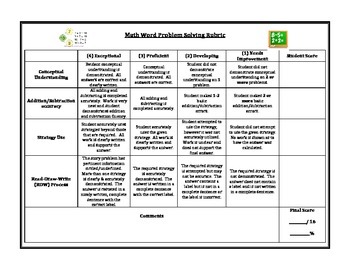Math Problem Solving Rubric and Student Checklist (addition and subtraction)
Lauren Jacobs
7 Followers
Grade Levels
1st - 5th
Subjects
Resource Type
Standards
CCSS2.OA.A.1
Formats Included
- PDF
Lauren Jacobs
7 Followers
What educators are saying
My 2nd graders couldn't wait to use this resource multiple times.
I found the graphics and fonts very easy to read and simple.
It certainly did the job for me as a teacher and for my kids.
Thank you TPT for making my life's work more efficient and impactful!
Description
Make it easy to grade how well your students understand common core problem solving! Grade with a rubric instead of just marking answers right or wrong!
Included are two rubrics to assess math problem solving using addition and subtraction. One rubric is for basic problem solving. The second is for solving word problems. The rubrics assess conceptual understanding, addition/subtraction fact accuracy, and strategy use. The word problem rubric includes an additional category for the components of the RDW process (read-draw-write).
The components are scored using specific, easy to measure language (4 exceptional, 3 proficient, 2 developing, 1 needs improvement).
There is also a student self-check list that directly correlates with the components of the rubric. This makes it easy for students to guide their own thinking and also shows what they will be graded on. The rubric/checklist combination makes for clearly defined grades and involves the students in problem solving!
Included are two rubrics to assess math problem solving using addition and subtraction. One rubric is for basic problem solving. The second is for solving word problems. The rubrics assess conceptual understanding, addition/subtraction fact accuracy, and strategy use. The word problem rubric includes an additional category for the components of the RDW process (read-draw-write).
The components are scored using specific, easy to measure language (4 exceptional, 3 proficient, 2 developing, 1 needs improvement).
There is also a student self-check list that directly correlates with the components of the rubric. This makes it easy for students to guide their own thinking and also shows what they will be graded on. The rubric/checklist combination makes for clearly defined grades and involves the students in problem solving!
Total Pages
Answer Key
N/A
Teaching Duration
N/A
Report this resource to TPT
Reported resources will be reviewed by our team. Report this resource to let us know if this resource violates TPT’s content guidelines.
Standards
to see state-specific standards (only available in the US).
CCSS2.OA.A.1
Use addition and subtraction within 100 to solve one- and two-step word problems involving situations of adding to, taking from, putting together, taking apart, and comparing, with unknowns in all positions, e.g., by using drawings and equations with a symbol for the unknown number to represent the problem.




